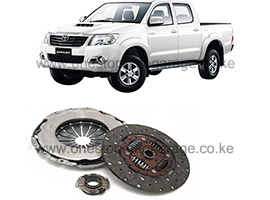-14%
Front stabilizer Links Toyota Vanguard, Rav 4 Aca3# in Nairobi, Kenya.
Unveiling the Significance of Stabilizer Links in Vehicle Suspension Systems
In the intricate choreography of automotive engineering, stabilizer links play a crucial role in orchestrating the movements of a vehicle’s suspension system. These seemingly modest components, also known as sway bar links or anti-roll bar links, wield a profound impact on the stability, handling, and overall driving experience. This exploration aims to uncover the importance of stabilizer links, delving into their functions, types, potential issues, and the far-reaching effects they have on the dynamic interplay of a vehicle’s components.
Understanding Stabilizer Links:
Stabilizer links are integral components of a vehicle’s suspension system, connecting the sway bar (or anti-roll bar) to other suspension components, typically the control arms or struts. Sway bars are essential for minimizing body roll during turns and maneuvers, and stabilizer links serve as the conduits that transmit the sway bar’s influence to the wheels.
Functions of Stabilizer Links:
- Body Roll Reduction: The primary function of stabilizer links is to mitigate body roll during cornering. As a vehicle navigates a turn, lateral forces are generated, causing the body to lean to one side. The sway bar, connected by stabilizer links, resists this motion, enhancing stability and preventing excessive tilting.
- Enhanced Stability: Stabilizer links contribute to the overall stability of a vehicle. By counteracting body roll, they ensure that weight distribution is more evenly maintained across all four wheels, improving traction and control.
- Improved Handling: The reduction of body roll facilitated by stabilizer links leads to improved handling dynamics. The vehicle responds more predictably to steering inputs, providing a more controlled and enjoyable driving experience.
- Tire Contact with Road: Stabilizer links play a role in maintaining optimal tire contact with the road surface. This is crucial for traction and responsiveness, especially during turns and sudden maneuvers.
Types of Stabilizer Links:
- Traditional Stabilizer Links: These are the most common type of stabilizer links, consisting of a straight metal rod with ball joints or bushings at each end. They are straightforward in design and widely used in various vehicle applications.
- Adjustable Stabilizer Links: In performance-oriented or customized vehicles, adjustable stabilizer links allow for fine-tuning of the sway bar’s effect. These links typically have threaded bodies, enabling users to adjust the length and preload of the link.
- Drop Links: Drop links are designed to accommodate lower or modified suspensions. They are often adjustable and can be adapted to different ride heights, ensuring proper sway bar function in diverse setups.
Importance of Stabilizer Links:
- Handling Precision: Stabilizer links play a pivotal role in maintaining handling precision. By controlling body roll, they ensure that the vehicle responds accurately to steering inputs, contributing to a more controlled and confident driving experience.
- Safety Enhancement: The stability provided by stabilizer links enhances overall safety. Reduced body roll minimizes the risk of rollovers, particularly in top-heavy vehicles, and contributes to more predictable handling in emergency situations.
- Traction Optimization: Stabilizer links contribute to optimal traction by preventing excessive weight transfer during cornering. This ensures that each tire maintains consistent contact with the road, improving grip and handling.
- Comfortable Ride: While stabilizer links enhance performance, they also contribute to a more comfortable ride. By minimizing body roll, passengers experience less lateral movement, resulting in a smoother and more pleasant journey.
- Prevention of Excessive Tire Wear: Properly functioning stabilizer links contribute to even tire wear. The consistent distribution of weight and reduced body roll help prevent uneven tread wear, extending the lifespan of tires.
Common Issues and Maintenance:
Despite their robust design, stabilizer links can face issues over time. Common problems include:
- Worn Bushings or Ball Joints: The bushings or ball joints at the ends of stabilizer links can wear out over time, leading to play and reduced effectiveness. Regular inspections are crucial for identifying and addressing this issue.
- Link Damage: Stabilizer links are exposed to the elements and road debris, making them susceptible to damage. Bent or broken links should be promptly replaced to maintain suspension performance.
- Lubrication Needs: Some stabilizer links have joints that require lubrication. Lack of proper lubrication can result in increased friction, leading to premature wear. Regular maintenance checks should include ensuring proper lubrication.
- Looseness or Play: Excessive play or looseness in stabilizer links can result in clunking noises, vibrations, and compromised handling. Timely replacement is necessary to restore optimal performance.
Conclusion:
In the intricate dance of vehicle dynamics, stabilizer links emerge as choreographers, influencing the interplay between suspension components and steering. Their role in reducing body roll, enhancing stability, and optimizing handling is foundational to the driving experience. Recognizing the importance of stabilizer links underscores the need for regular maintenance, inspections, and timely replacements to ensure the continued reliability and performance of a vehicle. These unassuming components, though concealed beneath the chassis, embody the precision and engineering excellence that define a safe, controlled, and enjoyable journey on the road.





